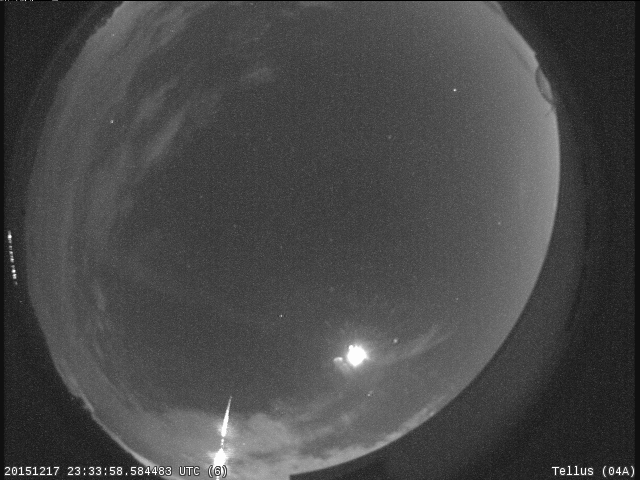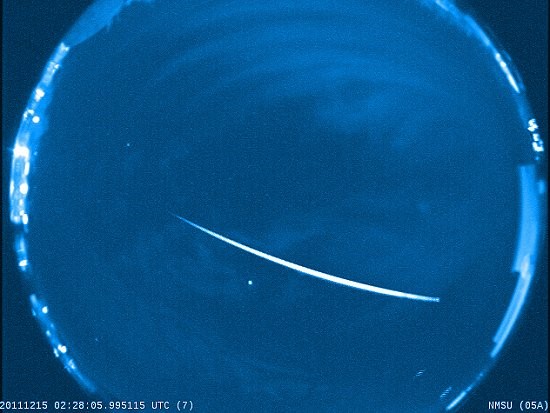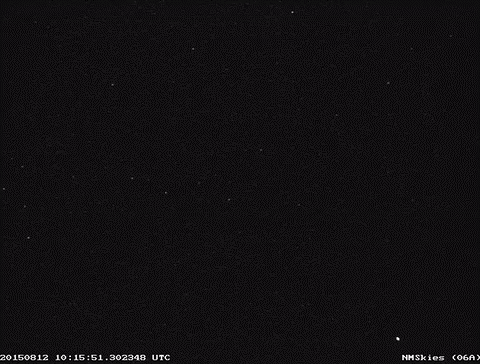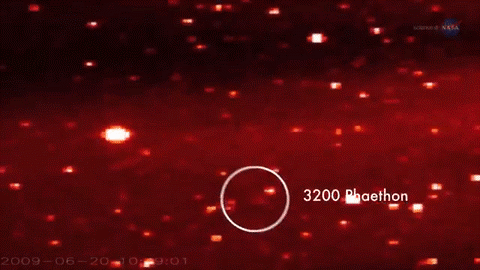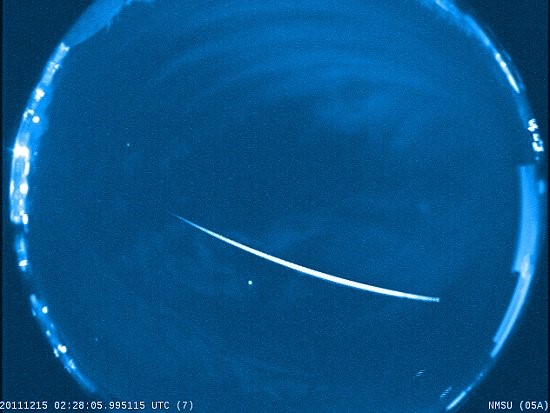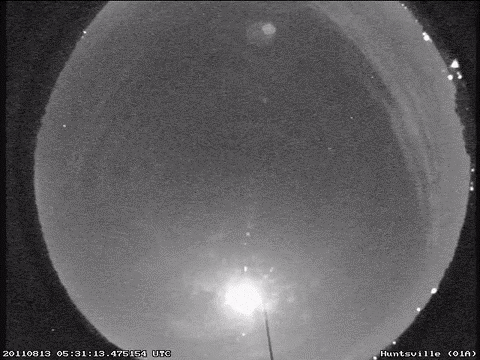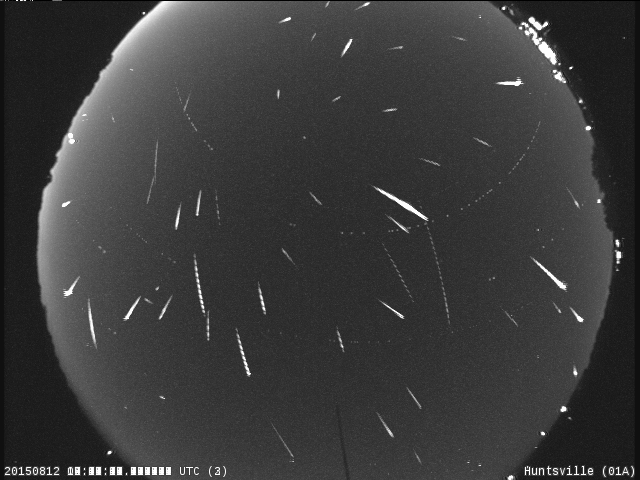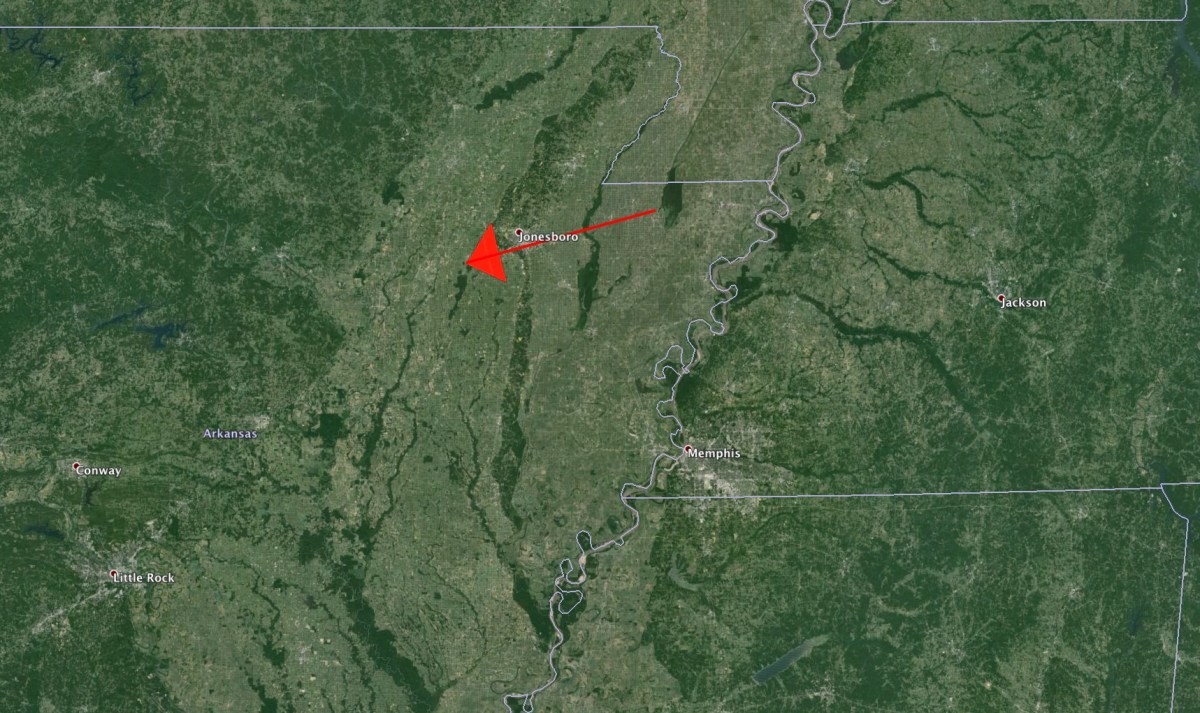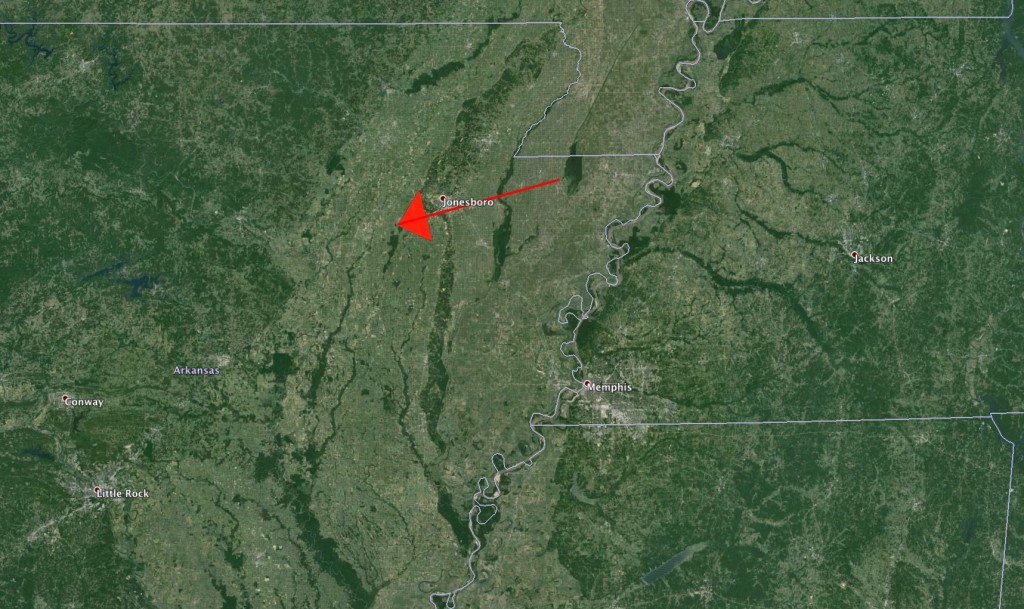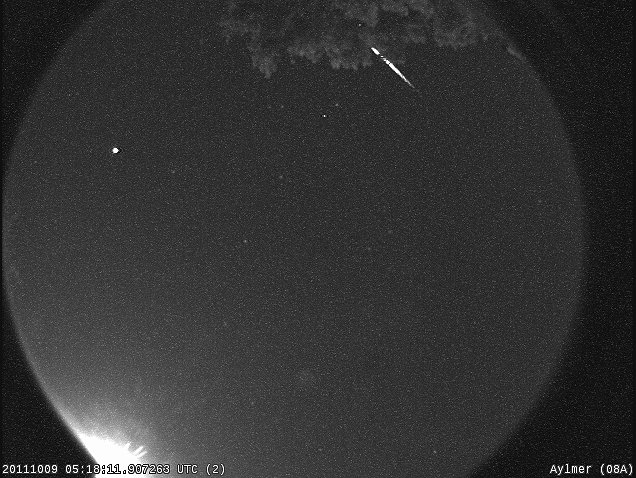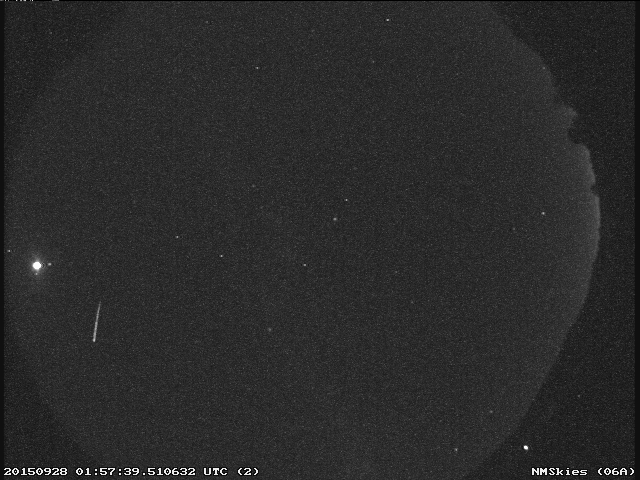NASA’s All Sky cameras captured this image of a Quadrantid meteor overnight, the meteor was moving at 93,000 miles per hour. This 1 inch diameter member of the Quadrantid meteor shower leaves a brilliant streak in the north Georgia skies before burning up 44 miles above Earth’s surface. The Quadrantid meteor shower peaks overnight on January 4.
Bright Fireball Detected by 6 NASA All Sky Cameras
https://www.youtube.com/watch?v=http://youtu.be/wGE7OQSCkyA[/embedyt]
We have received numerous reports concerning a bright fireball that occurred over Georgia at 5:33:55 PM CST (6:33:55 PM EST). All 6 NASA all sky meteor cameras in the Southeast picked up the meteor at an altitude of 50 miles above the town of Georgia (SE of Atlanta). From its brightness, it is estimated that this piece of an asteroid weighed at least 150 pounds and was over 16 inches in diameter. It entered the atmosphere at a steep angle and moved almost due south at a speed of 29,000 miles per hour. The NASA cameras tracked it to an altitude of 17 miles above the town of Locust Grove, where it had slowed to a speed of 9000 miles per hour, at which point the meteor ceased producing light by burning up. It is possible that fragments of this object survived to reach the ground as meteorites.
A more detailed analysis will be performed tomorrow and further details will follow if this analysis still indicates the possibility of a meteorite fall.
Ground track, still images from the cameras, and a movie from the NASA camera located in Cartersville, Georgia attached.
Join NASA’s Geminid Meteor Shower Tweet Chat on December 13-14
The Geminid meteor shower peaks on the night of December 13 through the morning of December 14. Geminid rates can get as high as 100 per hour, with many fireballs visible in the night sky. Best viewing is just before dawn.
NASA Tweet Chat: Observe the Geminid Meteor Shower
On the night of December 13, astronomer Bill Cooke from the Meteoroid Environment Office at NASA’s Marshall Space Flight Center will answer questions about the Geminid meteor shower via a live tweet chat. To ask questions, simply use the #askNASA or @NASA_Marshall. Cooke, Rhiannon Blaauw and Danielle Moser will be available to answer questions between the hours of 10 p.m. CST, beginning the evening of December 13, until 2 a.m. December 14 CST.
How to View the Geminid meteor shower
The best opportunity to see the Geminid Meteor shower is during the dark pre-dawn hours of December 14.
For optimal viewing find an open sky – because Geminid meteors come across the sky from many all directions.
Lie on the ground and look straight up into the dark sky. Again, it is important to be far away from artificial lights. Remember, your eyes can take up to thirty minutes to adjust to the darkness, so allow plenty of time for your eyes to adjust
About the Geminids
Geminids are pieces of debris from an object called 3200 Phaethon. Long thought to be an asteroid, Phaethon is now classified as an extinct comet. Basically it is the rocky skeleton of a comet that lost its ice after too many close encounters with the sun. Earth runs into a stream of debris from 3200 Phaethon every year in mid-December, causing meteors to fly from the constellation Gemini. When the Geminids first appeared in the early 19th century, shortly before the U.S. Civil War, the shower was weak and attracted little attention. There was no hint that it would ever become a major display.
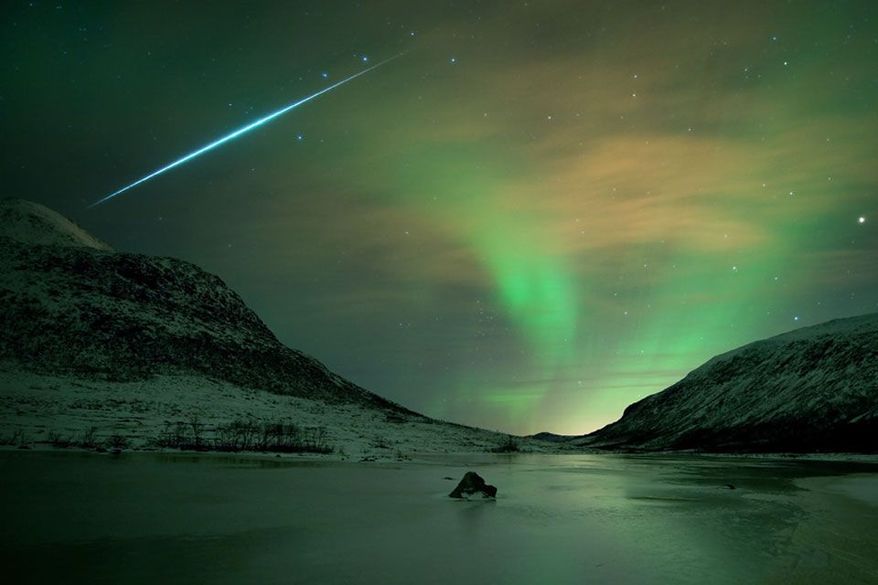
Five Fun Facts for the 2015 Geminid Meteor Shower
#1. The Geminid meteor shower can be seen from both the Northern and Southern hemispheres. Because they are pieces of an asteroid, Geminid meteoroids can penetrate deeper into Earth’s atmosphere than most other meteor showers, creating beautiful long arcs viewable for 1-2 seconds. Click the image to view a Geminid in action.
Marshall Space Flight Center will host a live Tweet Chat from 10 p.m. Dec. 13, until 2 a.m. on Dec. 14. Meteor experts Dr. Bill Cooke, Danielle Moser and Rhiannon Blaauw, all from NASA’s Meteoroid Environment Office, located at Marshall, will stay up late answering questions via Twitter. NASA followers interested in joining the online conversation can tweet their meteor questions to the Marshall Twitter account, @NASA_Marshall, or simply tag their tweets with #askNASA.
#2. Geminids are pieces of debris from an object called 3200 Phaethon. It was long thought to be an asteroid, but is now classified as an extinct comet.
Phaethon’s eccentric orbit around the sun brings it well inside the orbit of Mercury every 1.4 years. Traveling this close to the sun blasts Phaethon with solar heat that may boil jets of dust into the Geminid stream. Of all the debris streams earth passes through each year, the Geminid shower is the most massive. When we add up the amount of dust in this stream, it outweighs other streams by factors of 5 to 500. Click the image to view a Geminid in action.
#3. Because they are usually bright, many people say Geminid meteors show color. In addition to glowing white, they have been described as appearing yellow, green, or blue.
Geminid meteoroids hit earth’s atmosphere traveling 78,000 mph or 35 km/s. That may sound fast, but it is actually somewhat slow compared to other meteor showers.
#4. Geminids are named because the meteors seem to radiate from the constellation of Gemini. The shower lasts a couple of weeks, with meteors typically seen Dec. 4-17, peaking near Dec 13-14. Click the image to view a Geminid in action.
#5. The Geminids started out as a relatively weak meteor shower when first discovered in the early 19th century. Over time, it has grown into the strongest annual shower, with theoretical rates above 120 meteors per hour.
Fireball Seen in Early Evening Sky on Veterans Day
On November 11 at 5:41:17 PM CST there was a fireball detected on two NASA cameras; one located at Marshall Space Flight Center in Huntsville, Alabama and the other in Tullahoma, TN.
Last evening’s fireball was just across the Tennessee/Arkansas border over the town of Jonesboro, Arkansas (NW of Memphis – see ground track image below). Speed was about 43,000 mph, and the object weighed around 10 pounds (6 inches in diameter).
The orbit, which extends well beyond Mars, indicates that the meteoroid is a piece of an asteroid.
The Taurid Swarm is Upon Us!
Every year from September-November, the Earth passes through a broad stream of debris left by Comet Encke. The dust associated with the comet hits the Earth’s atmosphere at 65,000 mph and burns up, creating the Taurid meteor shower. Most years the shower is weak, and only a few Taurid meteors can be seen each night. Other years, the Taurids can put on a show.
This year, the Taurids may be more active than usual.
Bright Taurid fireballs may be more numerous this year, according to some scientists. Known as the Taurid “swarm,” these bright meteors are created when the Earth runs into a group of pebble-sized fragments from the comet that then burn up in the atmosphere.
“The annual Taurid meteor shower is going on right now, and we are seeing steady activity in our meteor cameras,” said Bill Cooke, lead for the NASA Meteoroid Environments Office. “Individuals should not be surprised if they see a bright meteor or fireball over the next few nights.”
Taurid meteors can be seen any time the constellation Taurus is above the horizon during the months of September, October, and November. The best time to look for Taurids is after midnight, when Taurus is high in the sky, and when the sky is dark and clear, with no moonlight to mask the fainter meteors. Given the behavior of past Taurid swarms, increased fireball activity may be seen during the last week of October and the first two weeks of November.
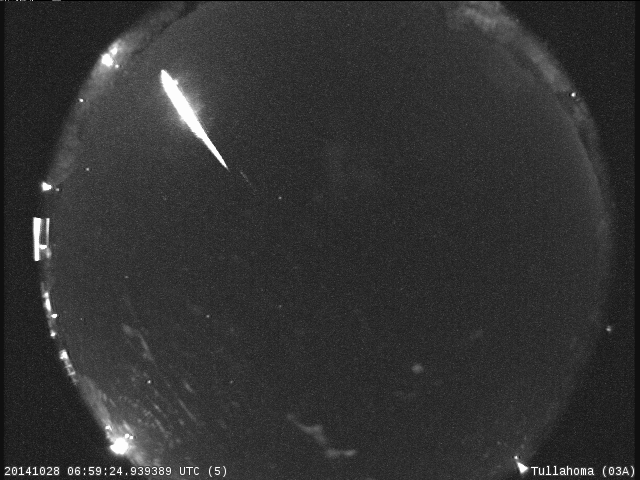
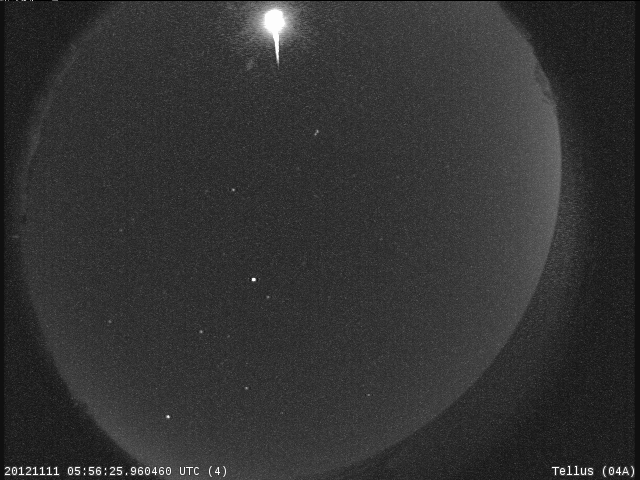
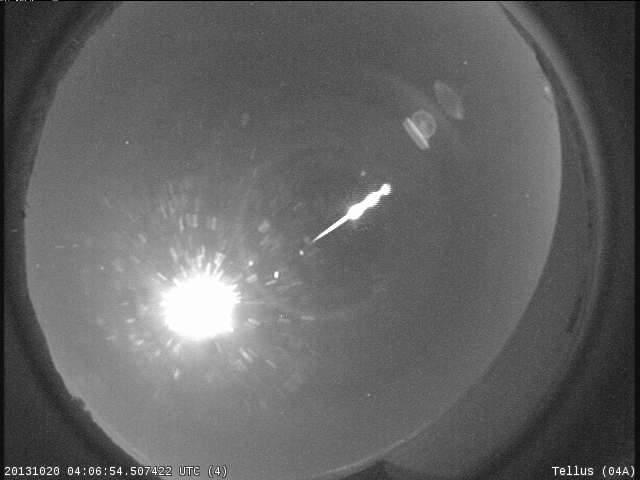
Images from the Peak of the Orionid Meteor Shower
A bright Orionid is captured on the peak night of the shower by a NASA all sky meteor camera in western North Carolina.
An Orionid cuts across Orion’s shoulders in this video recorded by a NASA wide field meteor camera at Marshall Space Flight Center. The 3 stars of Orion’s belt are clearly visible in the lower left corner of the image.
An Orionid heads south towards Orion’s belt in this video recorded by a NASA wide field meteor camera at Marshall Space Flight Center.
Annual Orionid Meteor Shower Peaks This Week
Orionid meteors appear every year around this time when Earth travels through an area of space littered with debris from Halley’s Comet. This year the peak will occur on the night of Wednesday, Oct. 21 into the morning of Thursday, Oct. 22.
“The Orionids will probably show weak activity this year,” says Bill Cooke of the NASA Meteoroid Environments Office . “Bits of comet dust hitting the atmosphere will probably give us about a dozen meteors per hour.”
The best time to look for Orionid meteors is just before sunrise on Thursday, October 22nd, when Earth encounters the densest part of Halley’s debris stream.
Observing is easy: Wake up a few hours before dawn, go outside and look up. No telescope is necessary to see Orionids shooting across the sky. Viewing conditions are favorable this year, as the light from the gibbous Moon should set by 2 a.m. EDT time, permitting good viewing just before dawn when the rates will be at their highest.
A live stream of the night sky from NASA’s Marshall Space Flight Center in Huntsville, Ala. will be available via Ustream beginning October 21, at 10 p.m. EDT. The live feed is an alternative for stargazers experiencing bad weather or light-polluted night skies. If the weather in Huntsville is clear, Orionids may be seen in the feed as early as 11:30 p.m. EDT, though the hours before dawn should show the most Orionid activity.
The display will be framed by some of the prettiest stars in the night sky. In addition to Orionids, you’ll see the Dog Star Sirius, bright winter constellations such as Orion, Gemini, and Taurus, and the planets Jupiter and Venus. Even if the shower is a dud, the rest of the sky is dynamite.
Set your alarm, brew some hot chocolate and enjoy the show!
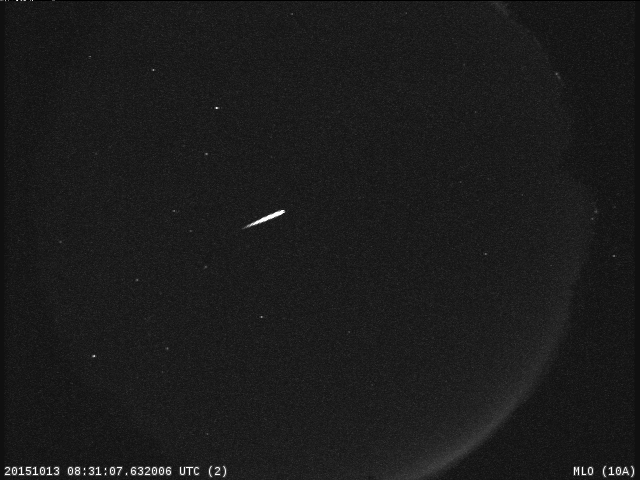
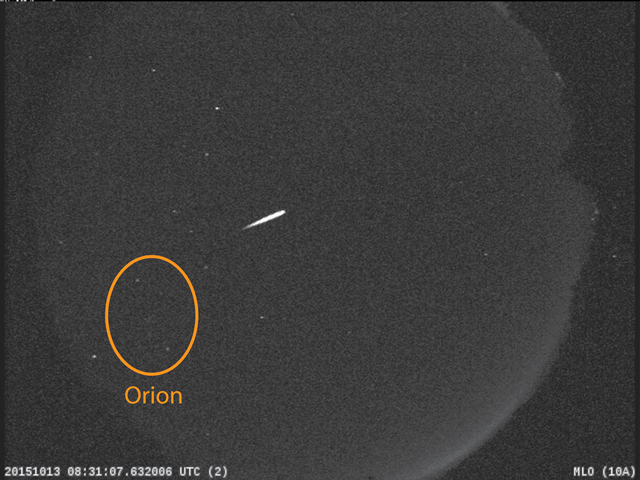
Draconid Meteor Shower Peaks October 8

The Draconids are an “occasional” shower – they are either in outburst, with a fair number of meteors, or are so few the casual observer would not notice them. Rates this year are expected to be about 10 per hour on the night of October 8 into the early morning of the 9th, most of them faint. The moon phase is favorable for the Draconid peak, so a sharp eyed observer may be able to spot a few during the course of the evening. The faintness of the Draconids is due in part to the fact that they are very slow for meteors, about 40,000 mph. As a consequence, it takes a larger Draconid to produce enough light to be really noticable (the brightness of a meteor is related to both its size and speed), and there are few of those unless the shower is in outburst, which is forecast to happen in 2018.
The next meteor shower is the Orionids on the night of October 21 into the morning of the 22. Rates are predicted to be about 20 per hour, and the gibbous Moon should set by 1 AM, permitting good viewing just before dawn when the rates will be at their highest


